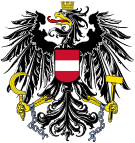| ||||||||||||||||||||||||||||||||||||||||||||||||||||||||||||||||||||
All 165 seats in the National Council of Austria 83 seats needed for a majority | ||||||||||||||||||||||||||||||||||||||||||||||||||||||||||||||||||||
|---|---|---|---|---|---|---|---|---|---|---|---|---|---|---|---|---|---|---|---|---|---|---|---|---|---|---|---|---|---|---|---|---|---|---|---|---|---|---|---|---|---|---|---|---|---|---|---|---|---|---|---|---|---|---|---|---|---|---|---|---|---|---|---|---|---|---|---|---|
| ||||||||||||||||||||||||||||||||||||||||||||||||||||||||||||||||||||
 Results of the election, showing seats won by constituency and nationwide. Constituencies are shaded according to the first-place party. | ||||||||||||||||||||||||||||||||||||||||||||||||||||||||||||||||||||
| ||||||||||||||||||||||||||||||||||||||||||||||||||||||||||||||||||||
| This article is part of a series on the |
| Politics of Austria |
|---|
 |
Parliamentary elections were held in Austria on 22 February 1953. They were the elections in which the Socialist Party received the most votes since 1920. However, the Austrian People's Party won the most seats. The grand coalition between the two parties was continued with Julius Raab replacing Leopold Figl as Chancellor of Austria, who had had to resign after facing criticism from his own party, and Adolf Schärf of the Socialist Party remaining Vice Chancellor.[1][2]
- ^ Leopold Figl Encyclopedia of Austria
- ^ Austrian Chancellors and Cabinets since 1945 Austrian Federal Chancellery




